Discovering Rocks Similar to Turquoise: A Guide
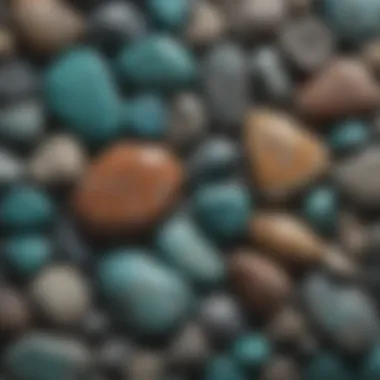
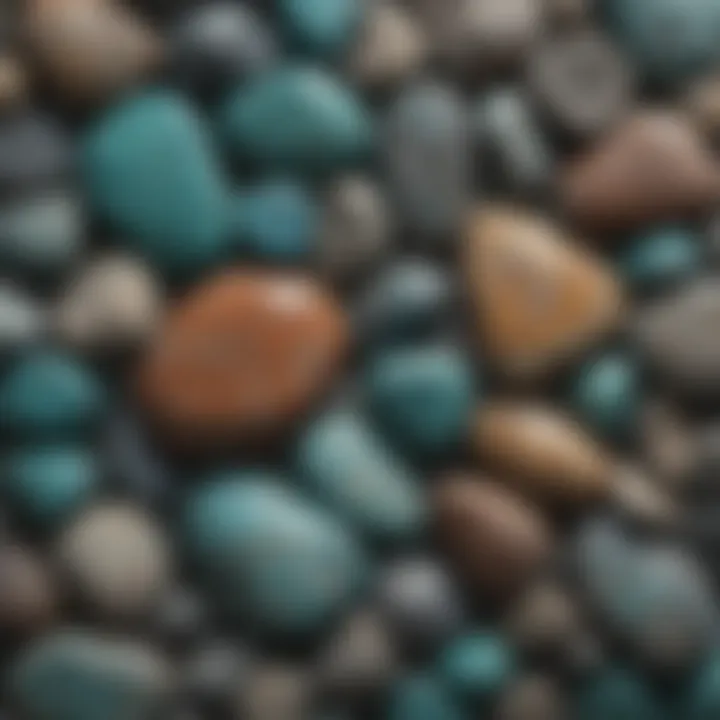
Intro
Exploring the realm of rocks that mimic the alluring hue of turquoise offers a journey into geological marvels. Turquoise itself is renowned for both its aesthetic appeal and its cultural significance. However, several other minerals and rocks can easily be mistaken for it. Understanding these variations is not only crucial for collectors but also enriches one's appreciation of the diverse world of geology.
The importance of identifying these rocks stretches beyond aesthetics; it touches on valuation and the care necessary to maintain their beauty. Armed with knowledge, collectors can make informed decisions about their acquisitions.
History and Origins
Overview of Collectibles, Rocks, and Fossils
The fascination with rocks and minerals can be traced back to ancient civilizations that valued them both for their beauty and believed properties. Collecting has transitioned from a mere hobby into a serious pursuit for many enthusiasts today. Rocks resembling turquoise, such as chrysocolla and howlite, often serve as key specimens in various collections. These rocks not only represent aesthetic enjoyment but also serve as educational tools that reveal stories of planetary formation and processes.
Historical Significance and Cultural Impact
The cultural impact of turquoise is profound, with its deep roots in Indigenous cultures across North America and the Middle East. It was considered a stone of protection and healing. Similarly, the rocks that resemble turquoise often inherit this significance, as they too carry stories of the earth's history. Knowledge about these stones can open discussions about ancient practices and the geological cycles that created them.
Identification and Classification
Guide to Identifying Rocks and Fossils
Identifying rocks that resemble turquoise requires a keen eye and some basic knowledge of mineralogy. Here are some points to consider:
- Color: Look for the characteristic blue and green hues.
- Luster: Observe how light reflects off the surface. Some stones may have a glassy appearance.
- Hardness: Use the Mohs scale to test hardness, as this can differentiate certain minerals.
- Inclusions: Inspect for any visible inclusions or patterns that are specific to a type of stone.
- Weight: Heftiness can also give clues; some look-alikes may be lighter than turquoise.
Common Types and Variations
Several stones commonly resemble turquoise, including:
- Chrysocolla: Often found in copper deposits, it exhibits vibrant blues similar to turquoise.
- Howlite: A soft white stone that can be dyed blue to imitate turquoise.
- Amazonite: Exhibits greenish-blue shades and can easily be confused with turquoise.
As you explore these rocks, recognizing their distinctive properties enhances appreciation for each stone's unique character.
Preface to Rocks that Look Like Turquoise
Understanding what rocks resemble turquoise is crucial for any collector or enthusiast. Turquoise has captivated people for centuries with its unique color and historical significance. However, many other minerals share a striking resemblance to turquoise, often leading to confusion in identification. This article aims to clarify this important distinction, providing insight into these stones that mimic the beloved turquoise.
Turquoise is not just a single mineral; it’s a combination of several elements and a marker of geological processes. Collectors and gem enthusiasts fondly seek turquoise for its luster and hue. However, when faced with other similar-looking specimens, one must be able to discern their unique qualities. This understanding not only enriches collection practices but also offers insight into the geological histories of these alternatives.
In this section, we will introduce the various aspects of turquoise-like rocks and explain their significance. Familiarity with these stones can aid in better identification processes and enhance the appreciation of each piece's uniqueness.
Understanding the Appeal of Turquoise-like Rocks
The attraction towards turquoise-like rocks stems from their aesthetic beauty, cultural relevance, and natural properties. Many people find the soft, blue-green tones appealing in jewelry and decorative arts. Turquoise has a historical connection to cultures around the world, commonly regarded as a stone of protection and healing.
When exploring the appeal of turquoise-like rocks, several elements come into play:
- Aesthetic Value: Turquoise-like stones attract collectors due to their vivid colors and patterns. Their visual appeal is similar to that of authentic turquoise, making them popular in various forms of art and jewelry.
- Cultural Significance: These stones often carry historical and spiritual meanings across different cultures. Understanding the stories behind them can deepen the collector's appreciation.
- Accessibility: While authentic turquoise can be expensive and harder to find, many look-alike rocks offer similar beauty at a more accessible price point. This affordability allows collectors to enjoy and experiment with different pieces without significant investment.
"The allure of turquoise-like rocks lies not only in their beauty but also in the narratives they encompass, resonating with collectors and enthusiasts alike."
Ultimately, exploring rocks that resemble turquoise expands one’s appreciation for geology and craftsmanship. Recognizing and understanding these minerals can lead to a richer collecting experience.
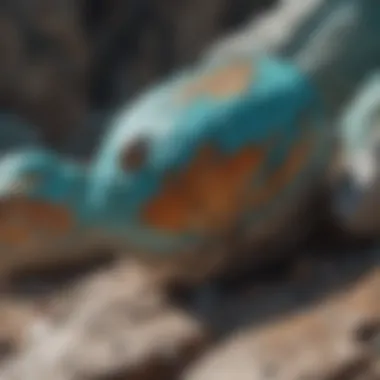
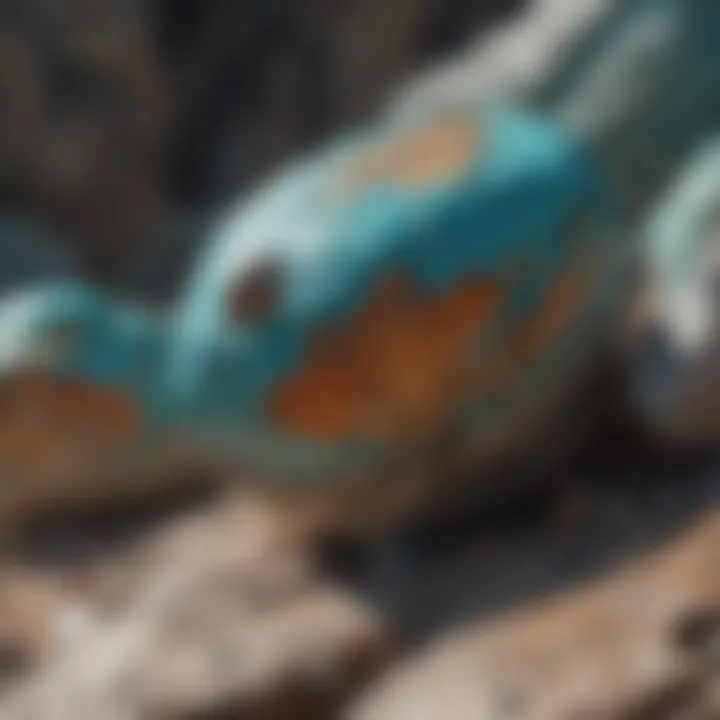
Geological Formation of Turquoise and its Alternatives
Understanding the geological formation of turquoise and similar rocks is important for anyone interested in the field of geology, gemology, or simply collecting. This section will elaborate on how turquoise forms through specific mineral processes and how alternate minerals can exhibit turquoise-like features. The exploration of these formations provides insight into the earth's natural processes and helps collectors distinguish between genuine turquoise and its lookalikes.
The Role of Copper in Turquoise Formation
Turquoise is classified as a phosphate mineral and primarily forms in arid regions. Its creation heavily relies on specific conditions that facilitate the interaction of water with copper-rich soils. Copper is a key element in turquoise's structure, as it promotes unique blue-green colors. The interaction happens when groundwater percolates through rocks containing copper minerals, dissolving and transporting these elements.
The final product is turquoise, which crystallizes when the conditions stabilize, creating a vivid coloration. The presence of other minerals, such as aluminum and phosphorus, also plays a significant part in defining the properties of turquoise. Copper thus is not just a component but a vital precursor in constructing both its aesthetic and physical characteristics.
Similar Processes in Other Minerals
Other minerals undergo formation processes akin to those of turquoise, often resulting in similar appearances but different compositions. Here are a few examples:
- Howlite: This mineral is often dyed to imitate the appearance of turquoise. It forms in sedimentary environments, generally around evaporative minerals. Its porous structure makes it susceptible to dyeing, enhancing its allure as a substitute.
- Blue Calcite: This carbonate mineral forms from the same geological processes, yet lacks the structural integrity of turquoise. Its color is present from trace amounts of other elements but does not possess significant durability, making it less desirable in jewelry compared to turquoise.
- Lapis Lazuli: Unlike turquoise, lapis lazuli is a metamorphic rock that owes its rich blue color to lazurite and other sulfide minerals. Its formation can be traced back to high-pressure environments, showcasing how different conditions yield similar, but chemically distinct, results.
- Chrysocolla: Often found in copper deposits, chrysocolla shares some aesthetic similarities with turquoise. Its blue-green hue results from copper silicate, imitating turquoise while maintaining distinct characteristics that can be identified under scrutiny.
These minerals highlight how geological settings and the elemental composition influence the visual similarities with turquoise.
Key Insight: Understanding the formation of these minerals can greatly aid collectors in distinguishing authentic turquoise from other rocks that may mimic its appearance.
Common Rocks Mimicking Turquoise
The subject of rocks that mimic turquoise is not just a matter of curiosity; it is crucial for collectors and enthusiasts to understand these alternatives. Key characteristics such as color, texture, and perceived value differ vastly among these stones. Identifying these rocks can prevent confusion and ensure that collectors make informed decisions in their pursuits. Having this knowledge allows buyers to appreciate the unique qualities of each stone, adding depth to their collections.
Howlite: A Façade of Turquoise
Howlite stands out as a notable alternative to turquoise. It is predominantly white or gray with black or brown veining that creates beautiful, marbled effects. Often dyed in vibrant blues, Howlite can closely resemble natural turquoise. This stone is softer, having a Mohs hardness of about 3.5, which makes it easier to work with for jewelry crafting. Collectors should be aware that while Howlite may captivate with its appearance, it lacks the unique properties of true turquoise. This distinction can influence its overall market value, often placing Howlite at a fraction of the price. Understanding its properties helps collectors appreciate its charm while knowing that it is not an equivalent of turquoise.
Blue Calcite: The Unassuming Impersonator
Blue Calcite is another rock that mimics turquoise's stunning color. Its gentle blue hues can range from soft pastels to vibrant shades. While it is often overlooked, the gemological community recognizes its beauty. The hardness of Blue Calcite is around 3, making it similar in terms of mineral structure but lacking the characteristic nuances found in turquoise. Its translucent quality gives it a unique appearance, often appealing to those who favor less saturated colors. Collectors seeking Blue Calcite should carefully assess its authenticity since imitations often flood the market.
Lapis Lazuli: A Royal Pretender
Lapis Lazuli is a historically significant stone that carries a rich blue color, interspersed with golden pyrite flecks. Often confused with turquoise due to its striking visuals, Lapis Lazuli has been cherished for centuries. Unlike turquoise, Lapis is composed mainly of lazurite, calcite, and pyrite, resulting in a more complex composition. The hardness level ranks from 5 to 5.5 on the Mohs scale, making it relatively durable. Understanding this difference aids collectors in determining the true worth of their specimens. The historical context also adds an allure; it has been used in jewelry, art, and decoration since ancient times. Thus, Lapis Lazuli embodies a unique position in collections, not merely as an imitation but as a distinguished gemstone.
Chrysocolla: The Green-Blue Duality
Chrysocolla showcases a distinctive green-blue coloration, making it a unique contender alongside turquoise. It often forms in copper-rich areas, giving it a soft, shimmering appearance. The hardness of Chrysocolla typically falls between 2 and 4 on the Mohs scale, which means it requires special handling in jewelry and ornamentation. Its distinctive nuances set it apart from turquoise, thus appealing to collectors who appreciate diversity and complexity in their collections. It is essential to identify this rock properly to enjoy both its aesthetic charm and cultural significance.
Distinguishing Features of Turquoise-like Rocks
Identifying rocks that resemble turquoise involves understanding specific distinguishing features. This knowledge significantly aids collectors in differentiating genuine turquoise from its substitutes and similar-looking minerals. Recognizing these characteristics can make the difference between a valuable specimen and a counterfeit.
Color Variations and Patterns
The first notable feature is the color variation seen in turquoise-like rocks. Natural turquoise exhibits a range of blues and greens, often with intricate matrix patterns. However, similar rocks may display distinct hues or veining that sets them apart. For instance, howlite often appears as white or light grey with black streaks, while lapis lazuli showcases striking golden pyrite flecks against a deep blue background.
Collectors should pay close attention to these subtle differences. A clearer understanding of colors helps in maintaining an extensive collection without confusion. When evaluating these stones, it's important to consider:
- Hue: The dominant color in the stone.
- Saturation: The intensity of the color.
- Tonal Variation: Subtle shifts in color across the surface.
- Matrix Patterns: Unique designs or lines that may appear in the stone.
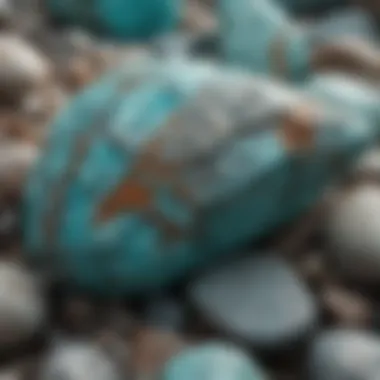
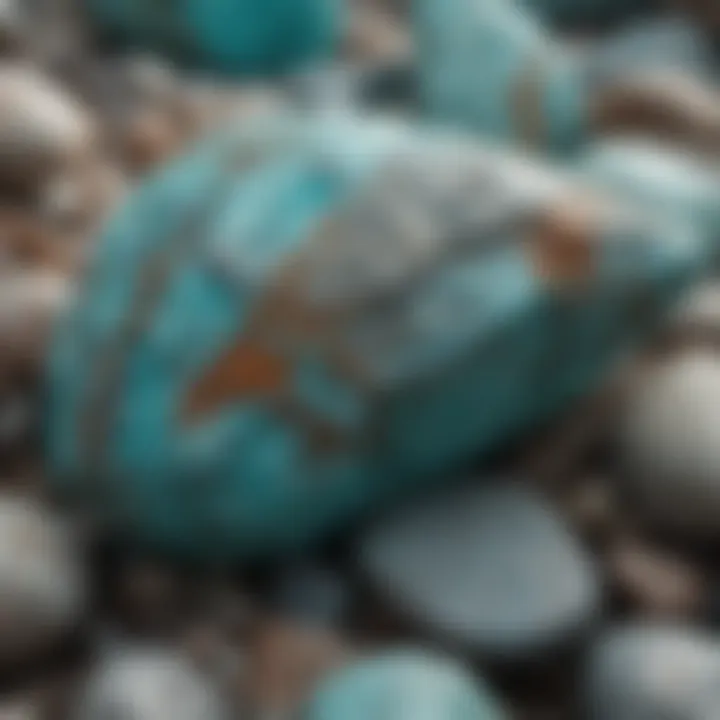
This observation not only helps in identification but also enriches the aesthetic appreciation of the specimens.
Luster and Surface Texture
The second critical aspect is luster and surface texture. Turquoise typically has a waxy to vitreous luster, making it glossy under light. Each turquoise-like rock may differ in surface finish. For instance, blue calcite might have a glassy shine, while chrysocolla can appear more dull or earthy.
Additionally, texture plays a role in differentiating these rocks. Some may feel smooth to touch while others may exhibit a more granular feel. When assessing luster and texture, collectors can consider:
- Glossiness: How shiny the surface appears.
- Finish: The overall feel and look of the surface.
- Crystallization: The presence of a crystal structure or a rough, uncut edge.
This detailed evaluation allows for more accurate identification and appreciation of the rocks, fostering a deeper connection between collectors and their specimens.
Understanding the distinguishing features of turquoise-like rocks is essential for anyone looking to collect them meaningfully. It transcends mere identification, enhancing the overall experience of collection.
Identification Techniques
Accurately identifying rocks that resemble turquoise is critical for collectors and enthusiasts alike. The right identification techniques can uncover the truths behind the surface appeal. Misidentifying a stone can lead to significant implications for its value, usage, and appreciation. Collectors should not only recognize the visual features but also understand the physical and chemical properties that characterize these minerals.
Visual Examination
Visual examination serves as the first step in identifying turquoise-like rocks. Observing color is crucial. Turquoise is typically blue to green, often with unique patterns. In contrast, some mimicking stones have lighter or darker shades. When examining a specimen, collectors should note:
- Color saturation
- Color variations and banding
- Presence of matrix lines or patterns
Luster also plays a vital role in visual identification. Turquoise is usually waxy to vitreous, but others like howlite may appear more dull. Observations should extend to the overall surface texture. A rougher surface may indicate a different mineral than smooth, polished turquoise.
Hardness Testing
Hardness testing provides insight into the mineral's composition. The Mohs scale is a common method for assessing a stone's hardness. Turquoise ranges around 5 to 6 on this scale. By using objects of known hardness, collectors can perform scratch tests:
- A copper coin can scratch materials softer than 3.
- A steel knife can scratch stones around 5.
If a specimen scratches easily with a coin, it likely is not turquoise. Not only does hardness testing aid in identification, but it also infers whether the stone can withstand wear over time. This understanding is essential when considering how to display or utilize the rock in collections.
Chemical Tests for Verification
For more precise identification, chemical tests can be beneficial. These methods often involve the use of acids or reagents to observe reactions:
- Acid Test: Vinegar can react uniquely with certain minerals. A fizzing reaction might indicate calcite or aragonite presence, steering away from turquoise.
- Simple Scratch Test with Acid: Place the stone on a slab and apply a drop of hydrochloric acid. If it bubbles, it suggests carbonate minerals, which are not features of genuine turquoise.
While these tests require care, they can validate or differentiate a stone conclusively. Given the market for turquoise-like rocks, such confirmation helps protect investments in valuable specimens.
In summation, using these identification techniques fosters a deeper appreciation for turquoise and its unique counterparts. Each method contributes to compiling a holistic understanding of the mineral's true identity.
Market Value of Turquoise-like Rocks
Understanding the market value of turquoise-like rocks is crucial for collectors and enthusiasts. The demand for these stones can fluctuate based on multiple factors, such as rarity, quality, and current market trends. Since many of these rocks are often misidentified or undervalued, having knowledge of their worth can guide collectors in making informed decisions. Additionally, awareness of the market can enhance the enjoyment and appreciation of these unique specimens, as collectors seek to expand their collections with pieces that not only have aesthetic value but also financial significance.
Factors Influencing Collectible Worth
Various elements play a role in determining the collectible worth of turquoise-like rocks. Here are some key factors:
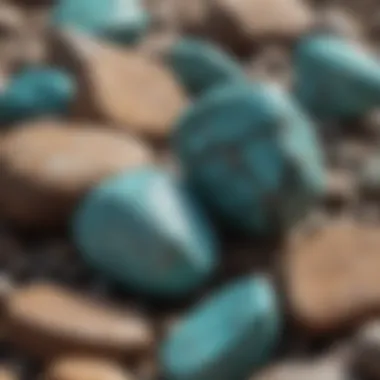
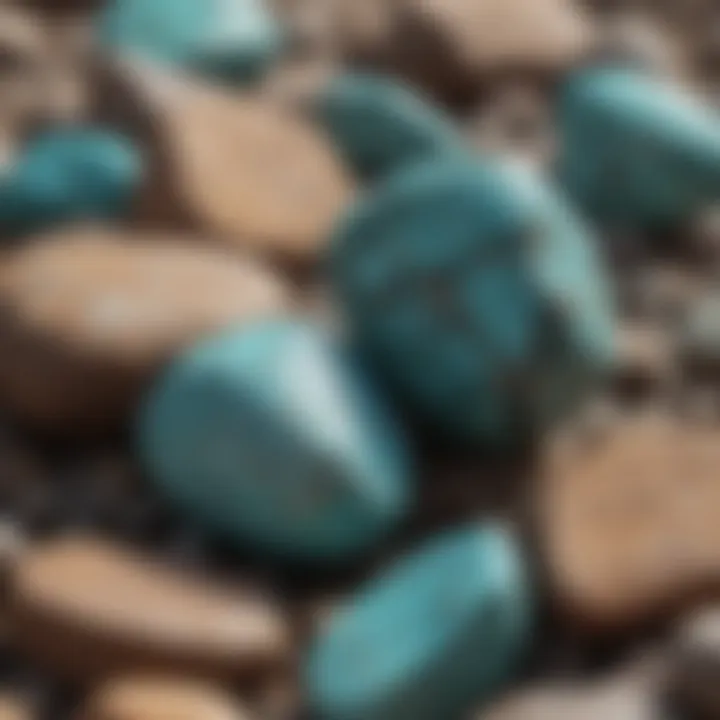
- Rarity: The availability of a particular rock type can significantly impact its value. Scarcity often leads to higher prices.
- Quality: The visual appeal of the rock, including color, pattern, and luster, can elevate its worth. Rocks with vibrant hues and beautiful matrix patterns are often sought after.
- Provenance: The origin of the rock can enhance its appeal. Specimens from renowned locations may carry a premium.
- Condition: Well-preserved specimens are more valuable than those with extensive wear or damage.
- Market Trends: The popularity of certain rocks can shift over time based on collector interest and fashion trends.
Collectors should keep an eye on these factors when assessing the potential worth of their acquisitions.
Comparative Analysis of Prices
When evaluating the market value of turquoise-like rocks, comparing prices across various sources is essential. Here are some observations:
- Online Marketplaces: Websites like eBay or Etsy often feature a wide range of prices for turquoise-like rocks. Some listings can provide insight into current market rates. Collectors can analyze these listings to spot discrepancies and trends.
- Gem Shows: Attending gem and mineral shows can offer firsthand experience with pricing. Dealers may provide comparative prices of similar specimens, allowing collectors to gauge a fair value.
- Auction Results: Auctions, either online or in-person, can yield useful price data. The final bid amounts for turquoise-like rocks of similar quality can serve as benchmarks for evaluating personal collections.
- Industry Reports: Consulting industry publications or websites dedicated to gemstones can provide detailed data on market trends and pricing structures.
A careful study of these pricing points will yield a clearer understanding of the market, helping collectors to navigate their investments wisely.
Caring for Turquoise-like Rocks
Caring for turquoise-like rocks is essential for both preservation and aesthetic purposes. These specimens, which often mimic the beauty of true turquoise, require specific attention to maintain their appearance and durability. Knowledge about cleaning methods and storage techniques can significantly enhance their lifespan and retain their value.
Cleaning Methods
Maintaining the cleanliness of turquoise-like rocks is crucial in preventing damage and enhancing their visual appeal. Cleaning should be conducted with great care to prevent any potential harm. Here are some effective methods:
- Gentle Soap and Water: Mix a small amount of mild soap with warm water. Use a soft cloth or a brush with soft bristles to gently clean the surface. Avoid harsh chemicals or abrasive tools, as they can scratch or dull the surface.
- Avoiding Submergence: Do not immerse the rocks in water for prolonged periods. Some minerals, like howlite or lapis lazuli, may absorb water, leading to discoloration.
- Drying: After cleaning, ensure the rocks are completely dry before storing. This helps to prevent moisture-related issues such as mold or further degradation of the stone.
- Specialized Cleaners: In some cases, professionals may recommend specific cleaners specially formulated for stones. Always test these on a small area first to ensure compatibility.
Proper Storage Techniques
The way turquoise-like rocks are stored is just as important as how they are cleaned. Proper storage prevents scratches and chips, preserving their visual aesthetic and value. Here are some recommended practices:
- Soft Storage Materials: Use soft cloths or pouches made from natural fabrics such as cotton or velvet to wrap the stones. This prevents unwanted friction that might occur with other hard materials.
- Avoiding Direct Sunlight: Store the rocks in a cool, dark place to prevent fading. Prolonged exposure to sunlight can lead to color changes, particularly in less stable varieties.
- Separation from Other Items: To avoid scratches and damage, store each piece separately. Using a display case with individual compartments is an excellent way to keep them organized and safe.
- Climate Control: Pay attention to the environment. Extreme temperatures and humidity can negatively impact the integrity of the stones. Finding a stable environment will help preserve their longevity.
Regular care through appropriate cleaning and careful storage significantly prolongs the beauty and value of turquoise-like rocks.
The Role of Turquoise-like Rocks in Culture
Turquoise-like rocks are more than mere geological specimens. They hold significant cultural value across many societies. These stones have, for centuries, been symbols of beauty, power, and protection. Understanding their cultural roles enriches our appreciation for these fascinating minerals.
Historical Significance
Turquoise has featured prominently in the history of various cultures. Ancient civilizations, such as the Egyptians and Native Americans, saw these stones as more than decorative. They believed these minerals possessed spiritual qualities. For instance, Egyptian pharaohs adorned themselves with turquoise jewelry to harness its supposed protective powers. The Native American tribes, especially the Pueblo people, used turquoise in their ceremonies, regarding it as a connection to the earth and sky.
Over the years, many turquoise-like rocks have also become part of folklore and tradition. Lapis Lazuli, for example, was highly prized in the ancient world, often used in amulets and masks. Its deep blue color symbolized truth and enlightenment. This historical context showcases not just their aesthetic appeal, but also their deeper connections with cultural identity and spiritual beliefs.
Modern Usage in Art and Decoration
In contemporary times, turquoise-like rocks continue to influence art and decoration. Artists and designers incorporate these minerals into various mediums. From jewelry making to interior design, they add a unique touch to creations. For example, Howlite is often dyed to resemble turquoise, gaining popularity in trendy accessories.
In interior spaces, people use stones like Blue Calcite for their calming aesthetic. These minerals create visually soothing environments, contributing to both residential and commercial designs. Additionally, museums and galleries display these rocks as part of a broader narrative on geological and cultural history. Their use today reflects an appreciation for natural beauty combined with an understanding of their historical roots.
Turquoise-like rocks embody a rich tapestry of historical and cultural influences that extend beyond mere decoration.
In summary, the role of turquoise-like rocks in culture is vast. Their significance runs deep, echoing through time from ancient artifacts to modern art. Recognizing this context enriches not only the collector's experience but also the broader understanding of humanity's relationship with the earth.
Culmination
The exploration of rocks that resemble turquoise is multi-faceted and offers a wealth of insights for collectors and enthusiasts alike. Understanding the intricate details surrounding these minerals can significantly enhance one's appreciation for them. As we have discussed, not all blue stones convey the same characteristics, and distinguishing between them is essential for accurate identification and valuation.
Identifying turquoise-like rocks is more than just a matter of aesthetics; it involves a comprehensive grasp of geological formation, surface textures, and chemical compositions. Each rock holds its unique story influenced by environmental factors and mineralogical processes. Collectors benefit greatly from this knowledge, not only in validating their collections but also in making informed purchasing decisions.
Another critical aspect to consider is the market value of these stones. Familiarity with the factors influencing their worth empowers collectors to engage with the market shrewdly. Beyond mere collection, understanding the care and maintenance needed for these minerals can preserve their value and enhance their visual appeal.
In summary, embracing a more profound understanding of turquoise-like rocks complements the joy of collecting. As enthusiasts apply this knowledge, they can enjoy their collections with greater awareness, leading to more meaningful engagements in the world of mineralogy.



